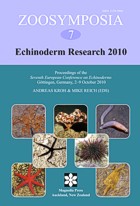Abstract
An ophiuroid assemblage from Rhaetian dark shales in a subrosion pipe (or sinkhole) penetrating middle Triassic (Muschelkalk) strata, and, outside the subrosion pipe, disconcordantly overlying middle Triassic strata, east of Winterswijk, the Netherlands, is described, discussed and assessed taxonomically. The material consists of nearly intact and articulated as well as wholly disintegrated skeletons, almost all of which are pyritised, yet so well preserved that the diagnostic characters could be studied in detail. All specimens belong to Aplocoma agassizi (von Münster, 1839). Examination of the type material of Ophiolepis damesii Wright, 1874 (housed at the Roemer and Pelizäus Museum in Hildesheim, Germany, collection numbers NKP 7821 to NKP 7828) from Rhaetian strata at Hildesheim, Germany, comparable to those exposed at Winterswijk, has revealed that O. damesii is to be considered a nomen dubium due to the insufficient preservation of the type material. Based on the present lot, which documents the first Triassic echinoderms from the well-known Winterswijk quarry complex, we suggest that the genus Aplocoma is best reassigned to the family Ophiolepididae, in proximity to the extant Ophiozonella, and that the family Aplocomidae is to be suppressed. From a palaeoecological point of view, the Winterswijk assemblage illustrates preservation under the influence of storms in an otherwise very quiet environment; it is here interpreted as a monospecific assemblage amidst an oligospecific bivalve community in a near-coastal, shallow, muddy setting with fluctuating or low salinity levels and/or dysoxic bottom waters.

